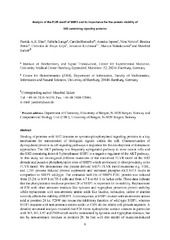| dc.contributor.author | Ehm, Patrick | |
| dc.contributor.author | Lange, Faabiola | |
| dc.contributor.author | Hentschel, Carolin | |
| dc.contributor.author | Jepsen, Anneke | |
| dc.contributor.author | Glück, Madeleine | |
| dc.contributor.author | Nelson, Nina | |
| dc.contributor.author | Bettin, Bettina | |
| dc.contributor.author | de Bruyn Kops, Christina | |
| dc.contributor.author | Kirchmair, Johannes | |
| dc.contributor.author | Nalaskowski, Marcus | |
| dc.contributor.author | Jücker, Manfred | |
| dc.date.accessioned | 2020-06-08T13:30:14Z | |
| dc.date.available | 2020-06-08T13:30:14Z | |
| dc.date.issued | 2019 | |
| dc.Published | Ehm, Lange, Hentschel, Jepsen, Glück, Nelson N, Bettin, de Bruyn Kops C, Kirchmair J, Nalaskowski, Jücker. Analysis of the FLVR motif of SHIP1 and its importance for the protein stability of SH2 containing signaling proteins. Cellular Signalling. 2019;63:109380 | eng |
| dc.identifier.issn | 1873-3913 | en_US |
| dc.identifier.issn | 0898-6568 | en_US |
| dc.identifier.uri | https://hdl.handle.net/1956/22492 | |
| dc.description.abstract | Binding of proteins with SH2 domains to tyrosine-phosphorylated signaling proteins is a key mechanism for transmission of biological signals within the cell. Characterization of dysregulated proteins in cell signaling pathways is important for the development of therapeutic approaches. The AKT pathway is a frequently upregulated pathway in most cancer cells and the SH2-containing inositol 5-phosphatase SHIP1 is a negative regulator of the AKT pathway. In this study we investigated different mutations of the conserved FLVR motif of the SH2 domain and putative phosphorylation sites of SHIP1 which are located in close proximity to its FLVR motif. We demonstrate that patient-derived SHIP1-FLVR motif mutations e.g. F28L, and L29F possess reduced protein expression and increased phospho-AKT-S473 levels in comparison to SHIP1 wildtype. The estimated half-life of SHIP1-F28L protein was reduced from 23.2 h to 0.89 h in TF-1 cells and from 4.7 h to 0.6 h in Jurkat cells. These data indicate that the phenylalanine residue at position 28 of SHIP1 is important for its stability. Replacement of F28 with other aromatic residues like tyrosine and tryptophan preserves protein stability while replacement with non-aromatic amino acids like leucine, isoleucine, valine or alanine severely affects the stability of SHIP1. In consequence, a SHIP1-mutant with an aromatic amino acid at position 28 i.e. F28W can rescue the inhibitory function of wild type SHIP1, whereas SHIP1-mutants with non-aromatic amino acids i.e. F28V do not inhibit cell growth anymore. A detailed structural analysis revealed that F28 forms hydrophobic surface contacts in particular with W5, I83, L97 and P100 which can be maintained by tyrosine and tryptophan residues, but not by non-aromatic residues at position 28. In line with this model of mutation-induced instability of SHIP1-F28L, treatment of cells with proteasomal inhibitor MG132 was able to rescue expression of SHIP1-F28L. In addition, mutation of putative phosphorylation sites S27 and S33 adjacent to the FLVR motif of SHIP1 have an influence on its protein stability. These results further support a functional role of SHIP1 as tumor suppressor protein and indicate a regulation of protein expression of SH2 domain containing proteins via the FLVR motif. | en_US |
| dc.language.iso | eng | eng |
| dc.publisher | Elsevier | en_US |
| dc.rights | Attribution-Non Commercial-No Derivatives CC BY-NC-ND | eng |
| dc.rights.uri | http://creativecommons.org/licenses/by-nc-nd/4.0/ | eng |
| dc.title | Analysis of the FLVR motif of SHIP1 and its importance for the protein stability of SH2 containing signaling proteins | en_US |
| dc.type | Peer reviewed | |
| dc.type | Journal article | |
| dc.date.updated | 2020-02-12T12:17:45Z | |
| dc.description.version | acceptedVersion | en_US |
| dc.rights.holder | Copyright 2019 Elsevier | en_US |
| dc.source.articlenumber | 109380 | |
| dc.identifier.doi | https://doi.org/10.1016/j.cellsig.2019.109380 | |
| dc.identifier.cristin | 1748210 | |
| dc.source.journal | Cellular Signalling | |
| dc.relation.project | Trond Mohn stiftelse: BFS2017TMT01 | |
| dc.identifier.citation | Cellular Signalling. 2019;63:109380 | |
| dc.source.volume | 63 | |

